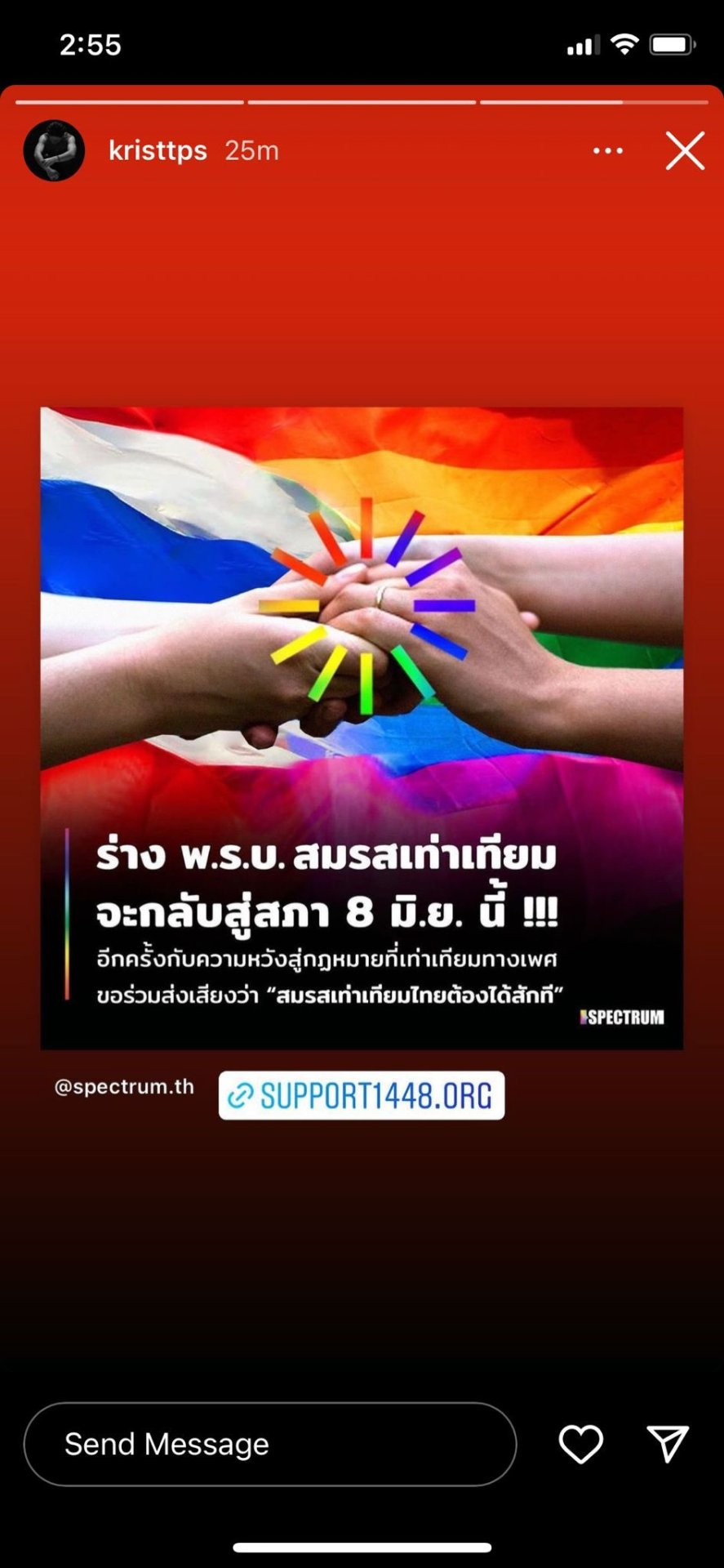#International Driver’s License Translation
Explore tagged Tumblr posts
Text
People Think Krist Is Homophobic (but He Isn’t)
[TW: discussions of homophobia, death threats, "the rape filter joke", etc.]
Last September, I made a thread about The Whole Krist Thing, and I'd like to make a version here on Tumblr as well.

NOTE: My being a queer fan of Krist doesn’t override the feelings or opinions of other queer people. I fully understand that time on this planet is limited and you don't need to exert precious energy into researching an actor. The reason I'm making this is to provide context for people who are new to the fandom or just wondering why Krist is known as homophobic.
- Why I Made the Twitter Thread -
As a queer international fan living abroad, my understanding of Thailand, Thai culture, and Thai language is extremely limited. Like most of us, I rely entirely on translations, both official and fan-made.
After watching SOTUS for the first time in 2020, I saw English-speaking fans claiming that Krist Perawat, the actor who played Arthit, was homophobic. And it wasn't just one or two people saying it. It was dozens. Hundreds. That called for some research. I loved Arthit, and Krist's empathetic portrayal of him didn't mesh with the angry guy in the Instagram photo I was seeing passed around.
I'd made a number of queer Peraya fans on Twitter, so I went to them individually and asked, "What's this about Krist being homophobic?" As queer fans who were knowledgable and openly fond of Krist, I wanted to hear their side of things.
They sent me links and photos and videos and translations that thoroughly explained how Krist's reputation for being homophobic had gotten so out of control. The problem: those things weren't compiled in one place, and they were all on Twitter where the Asian Peraya fandom is most active. Interfans, meanwhile, took the worst of everything they could find and compiled it into contextless videos for Instagram, YouTube, TikTok, etc. Since the vast majority of Krist's fanbase is spread across Asia and many of them don't engage with the international fandom, it's no wonder to me that the homophobia thing has become so ubiquitous over the years.
It's a paradox where, in order to see the evidence of Krist's allyship, you kind of have to be a fan already. Or you have to know which keywords to use to navigate Twitter's nightmare of a search function (I know, Tumblr is worse). While I made that thread, I was regularly texting Peraya I knew things like, "Do you know where that one interview from 2019 is?" or, "Did you take a screenshot of the marriage equality post he made last month?"
The thread was difficult to make, and I'm a fan! What I know of Krist, I know because I've been a fan for three years and I have access to information that fans who have been here much longer can find.
I also procrastinated on making it for ages. I knew the amount of vitriol people hold against him, and I just wanted to enjoy my time in fandom quietly without calling waves of anger and hate to my carefully curated little corner of sunshine.
Then Krist was in a car accident.
And even though he was reportedly driving safely and slowly, Thailand is notorious for its poorly maintained roads and a high number of traffic accidents. Only months after receiving his first driver's license, Krist's car flipped upside down, and he had to reassure fans from the hospital that he was physically all right, just shaken.
Meanwhile, some international fans thought it was funny.

And that's when I started making the thread.
So, with all that said, let's start with Krist's allyship, because I know most of us agree that that's the bare minimum for an actor working in the BL industry and profiting off the queer community.
- Acts of Allyship -
In the early days of their SOTUS fame, Krist and Singto were interviewed about the LGBTQ+ community.
Acceptance and equality is something that the LGBTQ community still struggles to achieve up to this day. But both Singto and Krist believe that this should not be the case. “They are just humans. They are like me, and they are like everyone,” Krist claims. Furthermore, he mentions that we should all be given the freedom to love anyone we want to love. “It’s just natural,” he says.
“They don’t have to understand now,” Singto says, referring to those who can’t grasp same-sex relationships. “One day, when they find their true love, they will realize that love is the same no matter the gender.” Krist adds, “Gender is not relevant when it comes to love. But in case some people still don’t understand this in time, what’s important is that we all give due respect to each other at the end of the day.”
He's also educated himself in colors representative of the LGBTQ+ community.

When Krist and Singto attended an award ceremony for their photoshoot in the gay magazine Attitude, Krist shared a sentiment that he gave to a queer friend of his. "If no one accepts you, you can stay with me, because I accept you for who you are." [Paraphrased]

Despite Thailand's current government leaning on BL series as a new soft power, it's still very conservative, and its people are to this day fighting to see equal marriage recognized.
Krist often adds his voice to this fight on Instagram, specifically as someone who works in the BL industry. These were in 2021 and 2022:




And, like many young people in Thailand, Krist also seems to support the Move Forward party. Earlier this week, he used an orange heart in a tweet to encourage people to go out and vote in the most recent election. One of the many things the Move Forward party is pushing for is the legalization of same-sex marriage "with the same rights and responsibilities as their heterosexual peers", which the current military government actively does not.

- His Circle -
When I was making my Twitter thread, I hesitated before including mention of his queer friends and coworkers. I knew how that would sound, but in the same way I felt it was important to mention my own queerness, I also think it's important to highlight not just the presence of queer people in his life, but how comfortable they are with him.
As I said in my Twitter thread, having queer friends isn’t indicative of anything substantial, but I do think it’s important to look at how those queer friends interact with him. If you’re queer, you know firsthand which friends you’d be physically affectionate with. The entertainment industry is its own world, of course, and the weight and meaning of relationships and connections can be different, but for all Krist's fame and popularity, he's not so famous or remotely powerful that faking a friendship with him is going to get them very far.
Among his queer friends, you've got Jennie who babies him, Godji who treats him like her son, and Oat who still adores him years after SOTUS. All of them queer, all of them visibly affectionate in a way that feels authentic, at least to me.





On the professional side of things, I think the best example of someone who wouldn't bother with him if he were homophobic is Golf Tanwarin Sukkhapisit. In 2022, Krist worked on The War of Flowers with Golf, a nonbinary queer activist, former MP, and director of The Eclipse. Since they're not just a queer person in the industry but a vocal queer activist who's made incredible progress for the community in their country, I value their judgment of his character.



Again, the reason I bring up these people isn't to say, "Look! Queer people! He knows some!"
It's to point out that he's close to them, and it disrespects their judgment to casually assume that they’d cosy up to a homophobe.
It's a small point, yes, but it was important to me when I first became a fan to see that queer people who know him personally had "vetted" him.
- Growth -
For this next section, I'll address three things I see brought up most often: the rape filter joke, the rumor that Krist said he doesn't like watching men kiss, and the claim that he's only doing BL because rent is due.
1) The Rape Filter Joke
In 2017, Krist and Singto were on a live with (I think) two other friends. They were testing out different filters, and when they got to a blur effect, one of them (one of the friends, I think) said it looked like the filter they put over victims of sexual assault on the news. They all laughed, including Krist and Singto.
I can't find a video of the original event, but we do have a translation of the apology he gave in 2018, and the public apology he made in 2020 when the video resurfaced again.

While this is unfortunate, and it would be nice if he hadn’t done it, I’m more interested in how he responds to criticism and his growth afterward. The incident was in 2017, but even speaking on it in 2020, he didn't make excuses for himself.
He apologized, accepted culpability, educated himself, and has never repeated it.
2) Krist "Doesn't Like to Watch Men Kiss"
There's also a claim that goes around that Krist said he doesn't like to watch men kiss. But that isn't what he said.
The subtitled interview that this claim was taken from has been split into two parts, and I think a lot of people have only seen the first half, if they've seen either.
(Also, my deepest apologies, but I'm linking you to Twitter for the video clips.)
In the first clip, the hosts tease Krist about Singto's sex scene with another actor in Close Friends. I can't speak to the nuances of what Krist is saying in Thai, but in the subtitles, he's basically saying that as a guy, he doesn't want to watch stuff like that and just skips past Singto and his partner to one of the other couples, like the male-female pairs. With just this clip, I agree that it doesn't sound great.
But in the second clip, the hosts tease Krist until he admits that the "stuff" he doesn't want to watch is Singto specifically kissing people who aren't him. Krist's jealousy, especially when it comes to Singto, is a well-trod fanservice joke.


3) He's Doing BL Only for the Money
I mean, I have no idea, but it'd be very weird if this was true, because he hasn't been in a BL since 2018 (if you count Our Skyy), and he's doing very well for himself financially.
Listen, this is probably the least serious people get when they criticize him, but I'm including it because why not, this is already a thesis.
From what I understand based on actors' comments, BL roles don't make a lot of money for the actors. (Boun even quoted a surprisingly low daily salary recently, and I'll share it here if I find it again.) Of course, I imagine Krist has enough fame and clout that he gets paid more than most actors, but to be frank, he absolutely makes more from all his other work.
Apart from the acting work he's done, he hosts two music shows, he starred in a musical recently, GMM just flew him to Japan for the first leg of his Asia concert tour, he runs a restaurant with Wave, and he has a bunch of sponsorships. And that's off the top of my head. The car from his accident in 2021 was a luxury model, and he replaced it with another pretty soon afterward. I'm not bragging for him or anything, but the "he's just doing BL for the money" is an odd thing to say when he probably already earns more than most without doing it.
It would have been a better argument back in 2016 when Krist's family was deep in debt. Krist's said that his main motivation to join the entertainment industry back then was to pay off that debt for his family, and he did so with the money he made from SOTUS.
Krist has spoken in the past about wanting to do more BL roles, but GMM preferred that he work with Singto. Now that Singto's left GMM (likely to start his own agency), Krist is in Be My Favorite, so I think his explanation tracks.
It's also worth mentioning that you can do something for the money and also love what you do. In the case of SOTUS, Arthit wasn't just a role that made him money, he's the character who changed Krist's life. He honors Arthit to this day by always wearing the bracelet he wore to his audition and by naming his music studio "SUN St." after Arthit.


(This is a very minor point, but I don't think a homophobe would cherish a queer role to quite that extent even if it was their kick-off point. If anything, they'd probably try to bury the role and pretend their real success started later.)
- Perception of Sexuality -
I think the reason the IG story hits people so hard is because Krist's reaction makes it seem like he's horrified that people could even think he's gay. My understanding is that he was tired of people interrogating him about his sexuality.
Krist is very openly affectionate with the people he loves, regardless of gender, which is clear in the photos with his friends above. Thus, he's always been like that with Singto. They hug before every show, they sleep on each other, cuddle, what have you. All the stuff of people who have developed a tight bond over the years.
When Krist was asked if he was afraid that that would put off potential partners in the future (which, good god, the questions they're asked) Krist said he doesn't care how people perceive his sexuality.



This was in 2018, the year Our Skyy aired, and he's said similar things in passing before and since.
- Conclusion -
All of what I've posted here is just a slice of what's out there. This is just the stuff I could find with reliable English translations because I'm making this for an English-speaking audience. Krist's fans already know all of this, which is why he has queer fans in the first place, and a lot of them are just too tired by hate fatigue to keep correcting misinformation.
I'm not trying to get every person in the world to like Krist, I promise. He's not perfect. He's a loud mess, and while he has four cats who love him, they're also exhausted by him. I just happen to like loud, obnoxious people, especially when they're as kind as he is.
There are plenty of Thai actors I don't vibe with for any number of reasons ranging from serious to petty. You have my written permission to dislike some people.
The Instagram story he posted was a bad move, we're all agreed. He agrees. He's apologized multiple times over the years. Whether one accepts his apologies is each person’s right, and I understand if this is enough to turn people away.

I just hope it's clear that he's been a staunch ally of the queer community and remains so to this day.
Personally, I'm more upset about the question.

This isn't a question you ask anyone.
And this wasn't the first fan to ask him.
According to people who have been fans from the SOTUS era, Krist and Singto were both relentlessly dogged by fans about 1) their sexualities and 2) details about their relationship with each other. We've all likely seen it happen to actors today, but back in 2016, there weren't hundreds of BL actors vying for the spotlight, so the spotlight hit Krist and Singto in a way that we can't imagine today. Most of us, myself included, arrived in this fandom long after SOTUS's meteoric rise to popularity that ended up saving GMMTV from bankruptcy, but given how many fans still behave like they're entitled to know an actor's sexuality, I think it's safe to trust that it was relentless. Fans accusing Kit Connor of "queerbaiting" as recently as 2022 is proof of that.
At the end of the day, there are plenty of reasons to dislike Krist, just like there are to dislike any person on this planet. He's hyperactive, he's whiny, etc. He's not flawless, but I think he's more than shown through his actions that he isn't homophobic, either.
He's not some actor playing queer roles for clout. He's vocally supportive of queer rights, and he backed that up this week in the polls by voting for the most progressive party in his country who are actively pushing for marriage equality.
But like I said, you don't have to like him, so I'll end this post with a quote from a friend who doesn't like Krist for the funniest reason I've ever heard:
"I don't think Krist is homophobic. I just don't like him because he reminds me of every kindergartener who demanded my attention at the exact moment when I was carrying something that could spill – and then it did spill, and they laughed about it for five minutes."
443 notes
·
View notes
Text
Common Myths About International Driving Licenses
Traveling abroad and thinking of driving? If you’re considering getting an international driving license (IDL), you may have come across conflicting information about its purpose and utility.
Unfortunately, misconceptions about IDLs can lead to confusion for travelers. To clear the air, let’s explore the most common misunderstandings and how a smooth International Drivers LicenseOnline Application process can make your travel hassle-free.
Misconception 1: An IDL Is a Substitute for Your Regular License
One of the biggest misunderstandings is that an IDL serves as an independent license. In reality, an IDL is merely a supplementary document��a translation of your original license into multiple languages. It helps foreign officials or rental agencies understand your driving credentials. However, it does not replace your home-country license.
Example: If you're driving through France and present only your IDL, authorities will still require your local license to confirm your eligibility to drive. The IDL is only a supporting document.
Misconception 2: An IDL Is Accepted Everywhere
It’s easy to assume that an IDL is a universal pass for driving worldwide. However, the truth is that its acceptance depends on local laws. Some countries might require additional permits or reject IDLs issued by unauthorized providers. For instance, Japan only recognizes IDPs (International Driving Permits) issued by government-authorized entities.
Travel Tip: Research the requirements of your destination beforehand to avoid complications.
Misconception 3: It’s Unnecessary for Short Trips
You may think an IDL is overkill if you're only planning a short vacation. However, some rental companies and foreign authorities require an IDL even for a single-day car hire. In destinations like Mexico or Italy, not having an IDL could mean being turned away by car rental agencies.
Practical Advice: Carry an IDL for peace of mind, regardless of your trip’s duration.
Misconception 4: Any Provider Can Issue an IDL
While applying for an IDL online is convenient, not all providers are legitimate. Genuine IDPs are issued by government-approved agencies, ensuring they are recognized in your destination country. Be cautious when selecting an International Drivers License Online Application service to avoid fraudulent or invalid documents.
Misconception 5: It Shields You From Legal Consequences
An IDL doesn’t grant immunity from traffic laws. Violations like speeding, reckless driving, or running red lights will still incur penalties in foreign countries, whether or not you carry an IDL. It’s vital to familiarize yourself with local traffic rules before hitting the road.
Conclusion
Understanding the role and limitations of an international driving license can save you from unnecessary hassles. Always pair your IDL with a valid domestic license and ensure you know its legal standing in your travel destination. For a seamless experience, consider trusted platforms for your application. Driving abroad can be a breeze—when you’re well-prepared!
0 notes
Text
Your Essential Guide to Translating a Driving License in Dubai

Verifying that your driver's license is current and recognised by the local government is one of the most important prerequisites if you intend to live or work in Dubai. You might have to get your driver's license translated into Arabic as part of the procedure. For foreign citizens and expats with a driver's license from their native country, this is a standard requirement.
In this blog, we’ll take you through everything you need to know about driving license translation in Dubai, including the process, the importance of certified translations, and why working with a professional translation service is crucial.
Why is Driving License Translation Required in Dubai?
Being a major international centre for travel and commerce, Dubai is home to a multicultural community of expats from all over the world. Although many nationalities are able to drive with their international licenses, local use frequently need an official translation. This is mainly because the Dubai Roads and Transport Authority (RTA) and other officials speak Arabic as their major language. Therefore, it is necessary to translate any foreign papers into Arabic in order to guarantee their comprehension and legal acceptance.
Here are the main reasons why driving license translation in Dubai is essential:
Legal Compliance: Your international driver's license must be in Arabic, according to local authorities, such as police officers, traffic department representatives, and licensing offices. When you apply for a new licence, register a car, or are pulled over for a traffic infraction, your foreign licence could not be accepted if it is not properly translated.
Obtaining a UAE Driving License:A precise and authorised translation is frequently necessary if you want to convert your international driver's license to a UAE license. Although it is simpler to convert your driver's license in many countries that have reciprocal agreements with the United Arab Emirates, an official translation is still required.
Insurance and Vehicle Registration:In order to process your applications, insurance companies and car registration services might also request a translated copy of your driver's license.
The Process of Driving License Translation in Dubai
The process of translating your driving license in Dubai involves several key steps:
Check the Requirements:There may be distinct translation needs for various administrations or organisations. Although translating your licence into Arabic is generally required, the specific type of translation (certified, notarised, etc.) may differ.
Select a Certified Translation Service:Using a licensed translation service in Dubai is essential. A specialist who is qualified to offer legally binding translations that are approved by UAE authorities is known as a certified translator. Certified translation is provided by translation services in Dubai, including Al Resala Legal Translation Services, guaranteeing that government agencies will accept your documents.
Submit Your Documents: After deciding on a trustworthy translation provider, you will need to send in a copy of your original driver's license and any additional supporting documentation. Your driver's license will thereafter be translated into Arabic by the translation service.
Receive Your Translated Documents: You will receive the translated copy of your driver's license after the translation is finished. To guarantee the accuracy of the translation, you could additionally receive a notarised copy, depending on the service.
Submit the Translated License: Once you have the translation, you may submit it to the appropriate authorities for purposes such as acquiring driver's insurance, registering a car, or converting your driver's license.
Why Choose Professional Translation Services in Dubai?
While it might seem tempting to use online translation tools or non-certified translators, it’s essential to choose a professional translation service for the following reasons:
Accuracy: Your driver's license translation will be accurate and faithful to the original text if you choose an expert translation service. Your application may be delayed or rejected if the translation is incorrect.
Legal Validity: The authorities in Dubai legally acknowledge certified translations. Your documents will be in compliance with the law thanks to the legally binding translations provided by professional translation services like Al Resala Legal Translation Services, which are recognized by government organizations.
Fast Turnaround: Translation services that are trustworthy are aware of how vital it is to process your papers as soon as possible. They guarantee that you fulfil deadlines for crucial processes like car registration and acquiring a UAE driver's license by providing prompt and effective services.
Confidentiality: Your personal information is kept private by using expert translation services. When handling private papers like your driver's license, this is crucial.
Comprehensive Services: Certified translation services frequently provide a broad range of language services, including translating official documents, contracts, and legal documents, in addition to translating driver's licenses. They are prepared to help with any of your translation requirements in Dubai.
What Documents Need Translation?
When applying for a driving license in Dubai, you may be required to translate the following documents:
Original Driving License: The most important document to translate is your current driving license from your home country.
Passport: Some authorities may ask for a copy of your passport as proof of identity.
Residency Permit: You may need to provide proof of your residency in Dubai, such as a valid Emirates ID or a residency visa.
Visa Status: If you're converting your license, you may need to submit a copy of your work visa or residency visa for verification.
Costs of Driving License Translation in Dubai
The service provider, the language pair, and the level of translation difficulty can all affect the price of driving licence translation in Dubai. Because certified translations have legal weight and must adhere to certain accuracy criteria, they are typically more expensive than conventional translations. When weighed against the possible expenses of mistakes or rejections by authorities, the price is often fair.
Prior to committing to any translation services, it is crucial to obtain a quote. Transparent pricing is a feature of trustworthy translation services like Al Resala Legal Translation Services.
Conclusion
For foreign citizens and expatriates who want to drive lawfully in the United Arab Emirates, driving licence translation is an essential step. You may be confident that your driver's license will be correctly translated into Arabic, adhere to local laws, and be approved by authorities by selecting a certified translation provider.
Get in touch with Al Resala Legal Translation Services right now if you're searching for trustworthy, qualified, and professional translation services in Dubai. In order to ensure seamless driving licence conversion, automobile registration, and other operations, we provide professional translation services that adhere to all legal criteria.
FAQs
Why is a translation of my driver's license required in Dubai?
The primary language of the Roads and Transport Authority (RTA) and other government agencies in Dubai is Arabic. For legal and governmental purposes, international documents—including driver's licenses—must be translated into Arabic.
Does my driver's license need the usage of certified translation services in Dubai?
Yes, in order for government officials to accept your driver's license, you must use professional translation services. These translations are legally binding and guarantee adherence to UAE regulations.
Can I utilise Dubai's online translation services for my driver's license?
No, official papers cannot be translated using internet resources. To make sure the translation is correct and enforceable in Dubai, you must work with a licensed translator.
In Dubai, how long does it take to translate a driver's license?
Depending on your documents' intricacy and the service provider, the translation procedure usually takes a few days. For urgent needs, expedited services could also be offered.
What paperwork must I bring to Dubai in order to get my driver's license translated? Your original driver's license, a copy of your passport, your residency permit, and your visa status are often required. Depending on the goal of the translation, certain agencies could want more papers.
0 notes
Text
Converting Your International Driving License in Australia: A Step-by-Step Guide
Converting Your International Driving License in Australia: A Step-by-Step Guide
A guide to converting your overseas licence: VicRoads

Understanding the Process
Converting your international driving license (IDL) to a domestic Australian license is a relatively straight forward process, but there are a few key steps involved. The specific requirements may vary slightly between states, so it's essential to check the guidelines for the state where you'll be residing.
General Steps:
Determine Eligibility:
Check if your IDL is valid and if the type of license you hold is equivalent to an Australian license.
Some states may have specific requirements regarding the duration of your overseas license or the type of vehicle you can drive.
Gather Necessary Documents:
Your valid international driving license
Proof of identity and residency in Australia
A certified English translation of your IDL (if it's not in English)
Medical certificate (if required)
Visit the Local Transport Authority:
Make an appointment at the nearest transport authority office in your state.
Bring all the necessary documents with you.
Complete Application Forms:
Fill out the required application forms, providing accurate information about your driving history and experience.
Undergo Assessments (if necessary):
Some states may require you to take driving tests or knowledge assessments to demonstrate your driving skills and understanding of Australian road rules.
Pay Fees:
Pay the applicable fees for the conversion process, tests, and the issuance of your Australian driver's license.
Receive Your Australian Driver's License:
While the general process is similar across Australian states, there may be slight variations. It's crucial to consult the official website of the transport authority in your state for the most accurate and up-to-date information.
Here are some resources for the major Australian states:
New South Wales: https://www.service.nsw.gov.au/transaction/transfer-an-interstate-driver-licence
Victoria: https://www.vicroads.vic.gov.au/licences/new-to-victoria
Queensland: https://www.qld.gov.au/transport/licensing/driver-licensing/overseas/transfer
South Australia: https://www.sa.gov.au/topics/driving-and-transport/licences/interstate-and-overseas/overseas-licence-transfer
Western Australia: https://www.transport.wa.gov.au/licensing/transferring-your-overseas-licence.asp
Northern Territory: https://nt.gov.au/driving/licence/new-nt-residents-and-visitors/transfer-your-overseas-licence
By following these steps and consulting the specific guidelines for your state, you can successfully convert your international driving license and enjoy driving in Australia.
New to Australia? Need to Learn to Drive?
Look no further than DOS Driving School. Our comprehensive courses and experienced driving instructors will equip you with the skills and knowledge needed to navigate Australian roads with confidence.
Book Your Driving Lessons Today
Phone: 03 8738 5185
Email: [email protected]
Mobile: 0490 049 705
#Converting Your International Driving License in Australia: A Step-by-Step Guide#Driving Tips#Safe Driving tips#driving test#driving school#driving license#driving lessons#driving#Driving in Melbourne#VicRoads#DOS Driving School
0 notes
Text
Complete Guide to Car Rental Requirements Iceland for Travelling Families In 2025
Hiring a car in Iceland is a great adventure that lets you travel through the country in your own time and with more freedom when touring with kids.
However, it is recommended to see and keep in mind a couple of factors that will give more pleasure in the process. For instance, when choosing a car, it would be worth it to focus on such parameters as the size of the trunk, availability of a child seat, and four-wheel drive if you are going to travel a lot on the F-road.

By carefully planning and preparing, you can make the most of your Icelandic road trip with your family. Here is a small list of all the important information for you!
What Will Travelling Families Need In Iceland In 2025?
· Age and License Requirements
Most car rental companies in Iceland require drivers to be at least 20 years old. However, some companies may have higher age limits, especially for specific vehicle categories like luxury cars or large SUVs. Drivers under this age often incur an additional young driver fee. An International Driving Permit (IDP) is highly recommended, especially if your driver's license is not in English, French, German, Spanish, or Italian.
An IDP serves as an official translation of your driver's license and can be helpful in case of unforeseen circumstances. A valid national driver's license from your home country is also essential.
· Insurance Coverage
These are probably the two most important kinds of insurance coverage: Collision Damage Waiver and Theft Protection. Both cover damage to the car as well as theft, respectively, but come with deductibles attached.
Super CDW and Super TP can be purchased for the rental of Ford Transit Rental Iceland with low or no deductible and the stress of financial loss is removed. One of the most important forms of car rental insurance covers sand and ash. This coverage safeguards the rental car against harm caused by volcanic ash, a major problem in Iceland.
· Winter Driving Considerations
Winter driving in Iceland can be challenging due to icy roads, snowstorms, and limited daylight. Such preparations are necessary. Iceland requires winter tires for winter. Most car rental firms include winter tires with rentals. However, always contact your rental firm for confirmation.
Experience with conditions of winter driving is a must. Be prepared to get into challenging road conditions and drive accordingly.
A 4WD vehicle is highly recommended for excellent winter driving conditions. In general, a 4WD vehicle is going to perform more favorably than other vehicles in handling conditions that are slick such as icy and snowy.
Here you will find the best cheap vehicle rental in our fleet.
· Knowing the Rental Terms & Conditions
Most car rental companies require the driver to be at least 20 years old and charge extra for drivers younger than 25. You will need a valid driver's license from your home country, and an International Driving Permit is recommended if your license is not in English.
Upgrades to Super Collision Damage Waiver (SCDW) and Super Theft Protection (STP) are needed for reduced or zero deductibles. Sand and Ash Protection is vital, especially in the case of volcanic eruptions.
Additional fees may apply, such as airport surcharges and winter tire fees. And these can add up over time even if you selected a cheap car rental Keflavik Airport in the beginning to save cost.
· Fuel Policy to Adhere To
Most of the car rental companies in Iceland will give you the vehicle on full-to-full, meaning the vehicle is to be returned with a full tank of fuel after receiving it with a full tank of fuel. The fuel level will be stated on the rental agreement at the time of picking up the car.
Look at the fuel gauge and ensure that you fill it up before handing it in. A number of the forestry gas stations in the rural parts of Iceland keep such limited hours that it is far more convenient for one to fill up the car in good time before they hand it back.
Some rentals have different fuel policies. Some rental companies may offer alternative fuel policies, such as paying a pre-paid fuel fee. The majority of the rental shops use fueling systems that measure fuel from full-full. Knowledge of fuel policy can effectively ensure that the renting of a car in Iceland experiences no drama.
Our detailed guide to Gas Stations in Iceland provides all the information you need, from current gas prices to tips on using self-service pumps, ensuring you’re well-prepared for your Icelandic adventure.
Click to read the full post and ensure your journey is as smooth and enjoyable.
· Preparing a Travel Kit
When planning a family road trip to Iceland, it's essential to prepare for unexpected situations. Every car should have an emergency kit, especially for the winter season including clothing, a blanket, food and water bottles, a first aid box, a flashlight, and a power bank. The tastes offered by Icelandic food are relatively varied, but it is advisable to carry some biscuits and other edibles in large quests for long travels. But, other concerns such as the diet of preference, food allergies, and restrictions within your family should also be considered.
Such a traveling kit can indeed make you have a good time on your trip and your family will have a very comfortable time. Some useful items include sunscreen, sunglasses, hats, raincoats, and walking shoes with good tread on them.
For kids, you might want to take snacks, candies, toys, etc for children so that they can keep themselves busy when on long journeys. It also recommended that one should also carry a car seat for better transport when carrying a child in the car. The above essentials are helpful for a family road trip planning and organizing while in advance in Iceland.
In Closing…
Having learned these requirements and tips, you can have a safe and fun road trip in Iceland even on crazy winter days. You should always read the conditions of renting provision and precisely check what is allowed in F-roads, and what penalties will be charged in case of returning the automobile late or infringing the requirements.
You must also be aware of the capacities of the car you are renting. For instance, Ford Transit Rental Iceland can open up avenues for many adventures that other base models cannot. All these tips when followed together can give you a trip of a lifetime with negligible worries to deal with!
#airport code kef#Car Rentals Iceland Airport#Car Rental Keflavik International Airport#Cheap Car Rental Keflavik Airport#code for iceland airport#car rentals iceland airport#rent a car iceland airport
0 notes
Text
International Driving Permit – Age Limit Explained

Importance of an International Driving Permit
An International Driving Permit (IDP) a document that allows individual to drive a private motor vehicle in another country when accompanied by a valid driver's license from their home country. This document provides a standardised translation of your driver's license and helps law enforcement officers and rental car agencies understand your driving credentials, overcoming language barriers.
How to become eligible for applying for an IDP
To become eligible for applying for an International Driving Permit, you must possess a valid driver's license from your home country. Additionally, some countries may require you to provide proof of identity, residency, and passport-sized photographs as part of the application process. It is crucial to understand the specific requirements of the country you intend to visit before applying for an IDP.
Step-by-step process to apply for an International Driving Permit
Step 1: Visit the ITCA Website. Go to e-itca.org.
Step 2: Fill out the application form by providing the following information:
Step 3: Upload Required Documents
Step 4: Choose IDP Validity and Delivery Options
Step 5: Make the Payment
Step 6: Submit Your Application
Step 7: Receive Your IDP
In conclusion, obtaining an International Driving Permit is essential for individuals planning to drive in foreign countries.
Age Limit for IDP Application
The age limit to apply for an International Driving Permit varies depending on the country issuing the permit. Typically, most countries require applicants to be at least 18 years old to obtain an IDP. It is essential to check the specific age requirements of the country you plan to visit before applying for an IDP.
Here are some specific age requirements in major countries:
Countries Requiring an International Driving Permit
Driving regulations and IDP requirements vary by country. Here’s a breakdown of countries requiring an IDP, organised by continent:
Africa
Asia
Europe
North America
South America
Oceania
Conclusion
Understanding the age requirements and knowing which countries require an IDP can make your international driving experience smoother and more enjoyable. Always check the specific requirements for your destination country before you travel. An IDP from ITCA can help ensure you’re prepared and legally ready to drive abroad. Safe travels!
0 notes
Text
Travel Tips for Beginners
Essential travel tips for beginners to make your journey smooth and stress-free. Learn how to plan, pack, and explore confidently for an unforgettable travel experience!
10 Travel Tips for Beginners
1. Plan Your First Night Even if your trip is spontaneous, plan your first night in detail. After a long travel day, you’ll be exhausted, and it’s helpful to get familiar with your surroundings before exploring further.

2. Photocopy Important Documents Make copies of your passport, visa, driver’s license, vaccination records, and other vital documents. Save scanned versions to the cloud so you can access them anywhere if needed.
3. Buy Essentials in Advance Purchase adapters, SIM cards, and foreign currency before leaving. It’s cheaper and saves you the hassle of searching for these items when you arrive.
4. Notify Your Bank Inform your bank and credit card companies about your travel plans to prevent card blocks. Check for any fees associated with international transactions.
5. Manage Your Phone Plan Contact your phone carrier to add international service, or purchase a local SIM card upon arrival to stay connected.
6. Secure Internet Access If working on the go, get a portable Wi-Fi hotspot and ensure your data plan covers international usage to avoid disruptions.
7. Pack Smart Bring versatile clothing that works for both day and night, preferably darker colors. Keep a change of clothes, medications, and essentials in your carry-on in case your luggage is delayed.
8. Carry a Travel Journal Document your experiences in a travel journal to preserve memories and reflect on your adventures for years to come.
9. Be Prepared for Language Barriers Even if you know the basics of the local language, carry a phrasebook for tricky situations. It’s a great backup if your translation app isn’t accessible.
10. Stay Positive and Enjoy Your first trip is a special milestone—smile, stay curious, and embrace the excitement of new experiences. Happy travels!
#TravelTips#FirstTimeTraveler#TravelPlanning#TravelEssentials#AdventureAwaits#ExploreTheWorld#TravelSmart#Wanderlust#TravelHacks#JourneyOfALifetime
1 note
·
View note
Text
Driving Abroad: Essential Documents for Indian Travelers by Rohit Kumar
Driving Abroad: Essential Documents for Indian Travelers by Rohit Kumar

As someone who loves road trips and exploring new destinations, there’s nothing quite like driving abroad. The freedom to stop wherever you want, discover hidden gems, and soak in the local scenery is unbeatable.
But before you hit the road in a foreign country, it’s important to know what documents you’ll need. Here’s my personal guide to the essential driving documents for Indian travelers abroad to make your journey smooth and stress-free.
1. International Driving Permit (IDP)
The International Driving Permit (IDP) is your golden ticket to legally drive in most countries. It’s an official document that translates your Indian driver’s license into multiple languages, making it easy for local authorities to recognize.
Where to Get It: You can apply for an IDP through your local RTO or online.
Validity: The IDP is typically valid for one year, so plan accordingly.
Why You Need It: Even if some countries allow driving with an Indian license, having an IDP ensures you’re covered in case of unforeseen circumstances like an accident or police check.
For a detailed guide on applying for an IDP and more tips, check out UK Visa Requirements for Indians.
2. Valid Indian Driver’s License

Your Indian driver’s license is the foundation for applying for an IDP and renting a car abroad. Ensure it’s valid for the duration of your trip.
Tip: If your license is close to expiring, renew it before your trip.
3. Car Rental Documents
Renting a car abroad requires certain paperwork. Here’s what you’ll need:
Passport: For identification purposes.
Credit Card: Most rental agencies require a credit card for deposits.
Insurance Proof: Rental agencies often offer insurance, but it’s a good idea to have your own coverage for added peace of mind.
For more tips on renting a car, read my guide on Car Rental Tips for Indians Abroad.
4. Travel Insurance

Travel insurance is a must for any international trip, but it’s particularly important when you’re driving abroad. Look for policies that cover:
Accidents: Coverage for damage to the rental car or third-party property.
Medical Emergencies: In case of injuries during your trip.
Roadside Assistance: For peace of mind during long road trips.
5. Vehicle Registration and Insurance
If you’re borrowing a vehicle or driving your own car across borders, ensure you have:
Vehicle Registration Documents
Insurance Certificate: Ensure the policy is valid in the country you’re visiting.
Pro Tips for Driving Abroad

Learn Local Rules: Every country has its own traffic laws and driving etiquette.
Drive on the Correct Side: Some countries drive on the left, like India, while others drive on the right. Familiarize yourself beforehand.
Carry a GPS or Map: A reliable navigation tool is essential for stress-free driving.
Stay Calm: Driving in a new country can be intimidating, but staying calm and confident makes all the difference.
Dream Destinations for Driving Abroad
If you’re looking for inspiration, here are some of my favorite destinations for driving:
Scenic UK Routes: Explore the picturesque countryside with ease. Read more about UK Visa Requirements for Indians.
Thailand Adventures: Drive through the bustling streets of Bangkok or head to serene beaches. Learn about Thailand Visa-Free Indians.
India’s Ultimate Road Trip: Sometimes, the best drives are closer to home. Check out my guide on the 14-Day Indian Road Trip.
Ready to Hit the Road?
Driving abroad is one of the best ways to explore a new country, offering unparalleled freedom and adventure. With the right documents in hand, you’ll be ready for the road trip of a lifetime.
For your International Driving Permit and more tips on driving abroad, visit International Drivers Association today.
Pack your bags, grab your keys, and get ready to create unforgettable memories behind the wheel! 😊
0 notes
Text
Essential Cancun Packing List: Must-Have Travel Gear

Cancun Packing List To Bring On Your Cancun Vacation
Estimated reading time: 4 minutes Planning a getaway to the stunning beaches of Cancun? Packing the right gear can make all the difference between a good vacation and an unforgettable one. Here's your essential Cancun packing list and guide to must-have items for your Mexican Caribbean adventure.

What to include in your Cancun Packing List
Cancun Beach Essentials
Your days in Cancun will likely revolve around sun, sand, and crystal-clear waters. Don't forget these items on your essential Cancun packing list: - A high-quality reef-safe sunscreen (SPF 50+ recommended) to protect both your skin and Cancun's delicate coral reefs - Multiple swimsuits - the humid climate means they may not dry overnight - A wide-brimmed sun hat and polarized sunglasses for eye protection - A lightweight, quick-dry beach towel that won't take up much luggage space - A waterproof phone case for underwater photos and protection from sand
Clothing & Accessories

Cancun's tropical climate demands strategic packing: - Lightweight, breathable clothing made from natural fibers like cotton or linen - At least one smart-casual outfit for upscale restaurants - Comfortable walking sandals and water shoes for beach activities, which are part of your essential Cancun packing list. - A light rain jacket or umbrella (especially during rainy season from June to October) - A small crossbody bag or waterproof backpack for day trips
Essential Health & Safety Items to add to your Cancun Packing List

Cancun Packing List - Bug Repellent Stay comfortable and protected: - Insect repellent with DEET for mosquito protection - After-sun lotion or aloe vera gel for inevitable sun exposure - Basic first-aid kit including bandages and anti-diarrheal medication - Hand sanitizer and wet wipes for on-the-go cleansing - Check the Sea Lice Season in the Caribbean
Tech & Documentation

Keep your Cancun vacation running smoothly: - Universal power adapter (Mexico uses Type A/B outlets, 127V) - Portable battery pack for long days away from power sources - See the Tax-Free Electronics Policies for Travelers to Cancun - Copies of important documents (passport, travel insurance, hotel and airport transportation bookings) are always part of an essential Cancun packing list. - Camera or GoPro for capturing underwater adventures - Download offline maps and translation apps before your trip - Check if your passport is valid. See this Passport & Visa Guide - If you have doubts about Visa, go to the official Foreign Mexico Affairs Website
Book Your Cancun Airport Transfer Before Arrival

Book your Cancun Airport private shuttle with Van.Travel - a trusted, official transportation provider offering direct hotel transfers. Safe, reliable service with licensed drivers at Cancun International Airport.
Extra Tips for your Cancun Packing List
- Pack a dry bag for water activities and boat tours - Bring cash for small purchases and tips (both USD and Mexican Pesos are widely accepted). See Monex Exchange Tips. - Check the current money exchange rate on your arrival as this may change frequently. Here is a useful tool to do that: Money Exchange Rates - Consider packing snorkel gear if you plan multiple snorkeling trips - it's often cheaper than renting - Leave space in your luggage for souvenirs from local markets, as part of your essential Cancun packing list.

Remember, Cancun has plenty of shopping options if you forget something, but having these essentials ready will help you make the most of your vacation from day one. ¡Buen viaje! - Essential Tips for Traveling to Mexico with Children - Sea Lice Season in Cancun - Current Mexico Exchange Rate at Cancun Airport - Cancun Airport Terminals - Airlines Guide - Cancun Airport Terminal 4 Expansion Read the full article
0 notes
Text
Insurance Coverage for Indian Drivers Abroad: What You Need to Know
by Anika Das

Traveling abroad brings a sense of adventure and discovery, especially when you’re behind the wheel, exploring new destinations at your own pace.
But for Indian drivers hitting the roads overseas, understanding insurance coverage is vital to ensure peace of mind. Here’s what you need to know about insurance as an Indian driver abroad and how to navigate your travel plans confidently.
Why Insurance Matters When Driving Abroad

Driving in another country comes with its set of challenges, from navigating unfamiliar roads to understanding local traffic laws. Having adequate insurance coverage means you’re protected from unexpected mishaps and costly out-of-pocket expenses. Plus, many countries require proof of insurance before allowing drivers on the road, so being prepared is essential.
Types of Insurance Coverage to Consider
Third-Party Liability Insurance: This is the minimum requirement in most countries. It covers damages to other vehicles and injuries to third parties in case of an accident.
Comprehensive Coverage: This type of policy offers broader protection, covering damage to your own vehicle, theft, and certain natural disasters. While it’s more expensive, comprehensive coverage is highly recommended for those who want added security.
Collision Damage Waiver (CDW): Typically offered by rental car companies, this waiver covers damage to the rental car itself. It's worth considering, especially if you're renting a car for city tours or exploring top Asian cities for family trips.
Personal Accident Insurance: This covers medical expenses for the driver and passengers in case of an accident. It’s a safety net that ensures medical bills don’t derail your trip.
Must-Have Tips for Indian Drivers

Check Your Existing Policy: Before purchasing additional insurance, check if your current Indian car insurance policy offers coverage abroad. Some comprehensive plans may extend limited international coverage.
Confirm with Your Rental Company: When renting a car, confirm what insurance options are available and what they cover. If you’re traveling with your family, reviewing tips for traveling with children abroad can make the journey safer and more enjoyable.
Essential Documents to Carry
Apart from insurance, there are important documents you should have on hand when driving abroad:
International Driver’s Permit (IDP): This is often required to drive legally in many countries and acts as a translation of your Indian driver’s license. For a smooth process, review our IDP Guide for Indian Travelers.
Copy of Your Insurance Policy: Always carry both digital and physical copies.
Passport and Visa: These are needed for identification at various checkpoints.
Navigating Insurance Claims Abroad

If you find yourself in an unfortunate situation where you need to make a claim, follow these steps:
Stay Calm and Contact Authorities: Inform local authorities if necessary and get a police report if it involves significant damage or injury.
Document the Incident: Take photos of any damages and collect contact information from involved parties.
Contact Your Insurer: Notify your insurance company as soon as possible and provide the necessary documentation.
Peace of Mind for Your Journey

Driving abroad as an Indian traveler is an incredible way to experience new places, but it’s important to be prepared. With the right insurance coverage, you can focus on the journey instead of worrying about potential issues. Whether you’re exploring bustling cityscapes or scenic countryside roads, being insured gives you the confidence to make the most of your trip.
Before you hit the road, ensure you’re equipped with all essential documents and a valid International Driver’s Permit (IDP). This small step can make a significant difference, turning potential roadblocks into a smooth driving experience.
Embark on your overseas adventure with peace of mind, knowing that you’re protected and prepared for anything that comes your way.
1 note
·
View note
Text
Reasons You Need a Driver's License Translation for International Travel.
Do you know about the importance of medical report translation is also essential when opting for translation of your driving license? Medical Report Translation in Birmingham is important for precise communication between patients and healthcare professionals, reducing mistakes and guaranteeing patient safety. Professional translators reduce incorrect diagnosis and treatment, particularly in ethnic settings where prompt and accurate interpretation is crucial.
0 notes
Text
What to Do If You Have a Problem with Your Airport Taxi

When traveling, smooth and timely airport transportation is key to a stress-free journey. However, issues with airport taxis can happen, even in well-regarded destinations like Jacksonville, FL. From delayed pick-ups to unprofessional drivers, knowing how to respond effectively can make a difference between a manageable delay and a travel nightmare. This guide will outline common problems, effective solutions, and proactive tips to ensure you enjoy a seamless airport taxi experience.
1. Understand the Common Issues with Airport Taxis
While airport taxis are generally reliable, certain challenges may arise. Here are some of the most common issues:
· Delayed or Missed Pick-ups: Sometimes taxis are late due to traffic, other client delays, or miscommunication between the driver and dispatch.
· Driver Misbehavior: Unprofessional behavior, such as rudeness, aggressive driving, or distractions like phone use, can disrupt your trip.
· Pricing Discrepancies: Unexpected charges or misunderstandings about rates can lead to disputes, especially for out-of-town travelers unfamiliar with local pricing.
· Navigation Issues: New or inexperienced drivers may get lost or take longer routes, leading to delays or higher fares.
· Vehicle Condition: Unclean or poorly maintained vehicles can affect comfort and safety.
· Communication Barriers: Language barriers or unfamiliarity with airport locations may lead to misunderstandings.
Knowing these common issues helps you remain vigilant and prepared, particularly when traveling to a busy hub like Jacksonville International Airport (JAX).
2. Steps to Resolve Issues with Your Airport Taxi in Jacksonville
Step 1: Communicate Directly with the Driver
If an issue arises during the trip, calmly communicate with the driver. Politely explain your concern, whether it’s about the route, pricing, or vehicle condition. For example:
· If the Taxi is Delayed: Contact the driver (if their number is available) to get an estimated arrival time.
· In Case of Driver Misconduct: Politely request that the driver follows appropriate road safety measures or stops any behavior that makes you uncomfortable.
If language is a barrier, consider using a translation app. In most cases, drivers are willing to address concerns, especially if you approach them with respect.
Step 2: Call the Taxi Company’s Customer Service Line
If the driver is unresponsive or the issue continues, contact the airport taxi company’s customer service number. Describe the problem in detail and mention the driver’s ID number, name, or vehicle license plate number if available. Reputable Airport Taxi Jacksonville FL, usually have customer service hotlines dedicated to handling complaints and inquiries.
For common providers of airport transportation in Jacksonville, such as Gator City Taxi and Yellow Cab, having their contact information on hand can expedite the resolution process.
Step 3: Document Everything
Documentation is essential if you need to escalate the issue. Take note of the following details:
· Date and Time: Keep a record of when the problem occurred, such as the pick-up time or the time the delay began.
· Driver Information: Record the driver’s name, license plate number, and the taxi company’s name.
· Receipts and Transactions: Save your receipt, as it contains important information like the fare, route, and contact details.
· Photos and Videos: For serious issues, such as an unclean vehicle or unsafe driving, photos or short videos can serve as proof.
Step 4: Contact Airport Customer Service
If the taxi service does not respond, reach out to the customer service team at Jacksonville International Airport (JAX). Airport staff often assist with transportation-related issues and may help connect you with the appropriate authorities. Many airports, including JAX, work with local taxi providers to ensure quality standards are maintained.
Step 5: Request a Refund or Compensation
For severe issues, such as missed flights or unprofessional behavior, you may be eligible for a refund or compensation. Contact the taxi company’s customer service and inquire about their refund policy. For instance, Gator City Taxi and other Jacksonville providers often have policies in place to handle grievances and offer partial refunds, discounts on future rides, or even full refunds under certain circumstances.
Step 6: File a Complaint with Local Authorities if Necessary
In extreme cases where the taxi company fails to address the issue, you may file a complaint with the Jacksonville Department of Transportation or the Better Business Bureau (BBB). Provide detailed documentation of the incident, including receipts and any communication with the taxi company. These authorities may investigate complaints and ensure that companies adhere to transportation standards.
3. Proactive Tips to Avoid Taxi Issues
Avoiding airport taxi problems is possible with a few proactive steps. Here’s how you can minimize the risk of a problematic experience with airport transportation in Jacksonville:
Choose a Reputable Taxi Service
Opt for established and well-reviewed taxi providers, such as Yellow Cab or Gator City Taxi in Jacksonville. These companies are often contracted by Jacksonville International Airport and adhere to strict customer service standards. Reading recent online reviews can also help you assess the reliability of a particular service.
Confirm Your Booking in Advance
If you have prearranged your airport taxi, confirm the booking the day before your flight. This reduces the likelihood of missed or delayed pick-ups, as the taxi company is aware of your schedule. Many services offer SMS or email confirmations with driver details, making it easy to get in touch if there are any last-minute changes.
Use a Taxi Booking App
Consider using a taxi booking app that allows you to track your driver’s location and estimated time of arrival. While Jacksonville airport transportation services may not have proprietary apps like Uber or Lyft, some established local services work with apps like Curb, which offer GPS tracking, upfront pricing, and instant feedback options.
Check the Fare Before You Book
If possible, ask for a fare estimate based on your destination. For trips to and from Jacksonville International Airport, most providers have set rates or price ranges. Clarify whether there are additional charges, such as airport fees or surcharges, to avoid surprises upon arrival.
Consider Alternatives
If you’re concerned about the reliability of an airport taxi, explore other transportation options:
· Airport Shuttles: Many Jacksonville hotels provide complimentary shuttle services to and from the airport.
· Rideshare Services: Apps like Uber and Lyft operate at JAX and offer price transparency and GPS tracking.
· Car Rentals: For greater flexibility, renting a car may be a better option, particularly for extended stays or trips to multiple locations.
4. How to Handle Specific Taxi Issues
· Long Wait Times at JAX: If the wait time for a taxi is long, consider using the airport’s rideshare pickup zone. Rideshare apps typically provide faster service and may reduce your wait time.
· Fare Overcharging: Politely remind the driver of the quoted rate or refer to the fare estimate. If the driver insists on overcharging, contact the taxi company immediately.
· Rude Driver: If a driver is rude or makes you uncomfortable, remain polite but assertive. End the trip if necessary and contact the taxi company’s customer service.
· Lost Items: Contact the taxi company immediately if you leave any items in the vehicle. Most providers have a lost-and-found process, but the sooner you report it, the higher your chances of recovering your belongings.
5. When to Contact the Jacksonville Transportation Authority (JTA)
If you’ve exhausted all options with the taxi company, the Jacksonville Transportation Authority (JTA) can provide additional assistance. JTA oversees transportation services in Jacksonville and can take complaints regarding unprofessional conduct, fare disputes, or safety concerns.
6. Why Choosing the Right Airport Taxi Provider Matters
Choosing the right airport taxi service can make a significant difference in your travel experience. Reputable companies prioritize customer service, ensure their drivers are trained and courteous, and keep their vehicles in good condition. For instance, providers like Yellow Cab and Gator City Taxi offer consistent service and are well-regarded for airport transportation in Jacksonville, FL.
Final Thoughts
While issues with airport taxis can disrupt your travel, knowing how to handle them effectively can turn a potential problem into a minor inconvenience. By choosing reliable airport transportation, staying proactive, and following the steps outlined above, you can ensure a smooth and hassle-free taxi experience in Jacksonville, FL.
0 notes
Text
Can International Students Learn to Drive in Melbourne?
Can International Students Learn to Drive in Melbourne?

Understanding Driving Eligibility for International Students
International students in Melbourne can learn to drive provided they meet certain conditions. Most students come to Australia on a student visa, which allows them to apply for a Victorian learner permit or driver’s license. Here’s what you’ll need to get started:
Valid Visa: Ensure your student visa is valid and permits you to stay in Australia for the required duration.
Proof of Identity: Documents like your passport, visa grant notice, and proof of residence in Melbourne are necessary.
Age Requirements: You must be at least 16 years old to apply for a learner permit in Victoria.
Understanding Road Rules: Familiarize yourself with Victorian road laws by studying the "Road to Solo Driving" handbook.
Steps to Learning to Drive in Melbourne
International students can follow these steps to begin their driving journey:
Obtain a Learner Permit: Pass the learner permit test to legally start learning to drive.
Enroll in a Driving School: Opting for a reputable school like DOS Driving School in Melbourne ensures high-quality training tailored to your needs.
Practice Driving: With a learner permit, you can take driving lessons with licensed instructors and practice under the supervision of an experienced driver.
Pass the Driving Test: Once you’ve accumulated adequate driving experience, you can book your driving test to obtain a probationary license
Why Choose DOS Driving School?
DOS Driving School in Melbourne specializes in helping international students navigate the local licensing process. Here’s what sets DOS apart:
Experienced Instructors: Their certified instructors understand the challenges faced by international students and provide clear, step-by-step guidance.
Flexible Scheduling: Lessons can be scheduled around your academic commitments, ensuring you can learn at your own pace.
Road Test Preparation: DOS Driving School offers comprehensive preparation for the Victorian driving test, ensuring you pass with confidence.
Multilingual Support: Instructors fluent in multiple languages can help you learn in your preferred language for better understanding.
Benefits of Driving as an International Student
Learning to drive in Melbourne offers several advantages:
Convenience: Avoid relying on public transport for daily commutes and errands.
Flexibility: Explore Melbourne and its surroundings, including the Great Ocean Road, Yarra Valley, and Mornington Peninsula, at your own pace.
Skill Development: Gaining a Victorian driver’s license adds a valuable skill to your resume, which might be useful for future job opportunities.
Cultural Integration: Driving helps you better understand Melbourne’s road culture and connect with locals.
Common Questions from International Students
Can I drive on my home country’s license? Yes, for a limited time, provided your license is in English or accompanied by an official translation. However, if you’re staying long-term, you’ll need to switch to a Victorian license.
How long does it take to get a license? The timeline depends on your prior experience. With proper training from DOS Driving School, you can prepare effectively and minimize delays.
Are driving lessons expensive? DOS Driving School offers competitive pricing and packages designed to suit student budgets
Final Thoughts
International students can absolutely learn to drive in Melbourne, and the process is straightforward with the right guidance. By choosing DOS Driving School, you gain access to experienced instructors, customized training, and support throughout the licensing process. Whether you’re aiming for greater independence, exploring Australia’s scenic routes, or enhancing your skill set, learning to drive in Melbourne is a worthwhile investment.
Ready to start your driving journey? Contact DOS Driving School today and take the first step towards driving confidently in Melbourne!
#Can International Students Learn to Drive in Melbourne?#driving tips#drive#driving license#driving school#driving test#driving lessons#Driving test#VicRoads test
0 notes
Text
Can I get a driving license on a tourist visa in Ontario?
In Ontario, it is generally not possible to obtain a full driving license on a tourist visa, as the Ontario Ministry of Transportation typically requires proof of residency in the province. However, as a tourist, you have a few options for driving legally in Ontario.
1. Driving with an International Driver’s Permit (IDP)
If you hold a valid driver’s license from your home country, you can drive in Ontario for up to 90 days using an International Driver’s Permit (IDP) along with your foreign driver’s license.
The IDP must be obtained in your home country before you arrive in Canada. It is a translation of your current license and is not a replacement for it.
2. Using Your Foreign Driver’s License
Visitors from certain countries may drive with their foreign driver’s license for up to 90 days without needing an IDP. However, it is highly recommended to have an IDP for convenience and to avoid any language barriers.
3. Applying for an Ontario Driver’s License
To apply for an Ontario driver’s license, you typically need to be a resident of Ontario, which means having a valid status other than a tourist visa, such as a work permit, student visa, or permanent residency.
You would need to provide proof of residency, legal status, and identity documents, which a tourist visa does not usually fulfill.
4. Temporary Licensing Exceptions
In some exceptional cases, long-term visitors on visas other than a tourist visa, such as long-term work or study permits, may qualify for a temporary license after meeting Ontario’s licensing requirements, including written and road tests.
Key Points:
Tourists cannot obtain a full Ontario driver’s license unless they change their status to one that allows residency.
Always carry your IDP and your foreign driver’s license while driving as a tourist.
Check specific requirements or any reciprocal agreements Ontario might have with your home country, as these can sometimes influence your eligibility to drive.
It's always best to check directly with the Ontario Ministry of Transportation or visit their official website for the most current and specific requirements related to driving as a visitor in Ontario.
0 notes
Text
International Driving Permit Online

Traveling abroad often means exploring new places and cultures, and sometimes, the best way to do that is by driving. But to drive legally in many foreign countries, you’ll need an International Driving Permit (IDP). What if you didn't hear about this document earlier and need an IDP asap to drive around? We've got your covered!
In this blog, we'll discuss:
What is an International Driving Permit (IDP)?
An International Driving Permit Online (IDP) is a document that allows you to drive a vehicle in another country legally. It translates your domestic driver's license into multiple languages, making it easier for foreign authorities to understand your credentials. An IDP is needed in 150+ countries for renting or driving a car abroad. It includes your name, photo, and driver information, which helps in identifying you and verifying your driving credentials abroad.
Why is an International Driving Permit needed?
An IDP simplifies many aspects of traveling, especially when driving in a foreign country.
How To Apply for an IDP?
Applying for an IDP is straightforward, whether you need a soft copy or a hard copy. Here’s how you can do it:
Applying for a Hard Copy International Driving Permit
Applying for a Soft Copy IDP
But if you are already abroad, here is how you can apply for a soft copy International Driving Permit might be more convenient. Here’s how to do it:
Documents Needed to Apply for an IDP
When applying for an IDP, whether a hard copy or a soft copy, you will generally need the following documents:
Conclusion
Applying for an International Driving Permit (IDP) while already abroad is entirely possible and can be done through both traditional and digital means. An IDP not only ensures legal compliance but also facilitates smoother communication with local authorities and car rental agencies, making your travel experience more enjoyable. By following the steps outlined above and leveraging resources like e-itca.org, you can easily obtain an IDP, whether you need a hard copy or a soft copy, ensuring you have the necessary documentation to drive legally and safely in foreign countries. Safe travels!
0 notes
Text
Filipino Drivers in Italy: Weathering Change, Building Credit, and Sharing Flavors
The Filipino diaspora is a complex and multifaceted phenomenon, driven by a variety of factors, from economic necessity to the pursuit of personal growth. Among the millions who venture overseas to build better futures for themselves and their families, Overseas Filipino Workers (OFWs) in Italy represent a significant and dynamic group. This article delves into the lives of these modern-day heroes, focusing on the unique challenges and opportunities they face, particularly within the context of drivers, credit building abroad, the looming threat of climate change, and the surprising role of culinary diplomacy in shaping their experiences.
The Road Less Traveled: Filipino Drivers in Italy
Driving in a foreign country can be daunting, but for many Filipinos in Italy, it’s a livelihood. From driving buses and trucks to working as personal chauffeurs, Filipino drivers navigate the Italian roadways and contribute significantly to the country's transportation sector. They face unique challenges, including language barriers, adapting to different traffic laws and road conditions, and often, dealing with cultural misunderstandings. The process of obtaining an Italian driver's license can also be complex, requiring translations of documents and passing both written and practical exams.
Furthermore, the gig economy has impacted the driving sector in Italy, creating both opportunities and precariousness for OFW drivers. While platforms like ride-sharing apps offer flexibility and potential for higher earnings, they also often lack the benefits and job security of traditional employment. This can make it difficult for OFW drivers to plan for the future and build financial stability.
Building a Financial Future: Credit and OFWs in Italy
Accessing financial services and building credit in a foreign country can be a significant hurdle for OFWs. Many arrive in Italy without a credit history, which can make it difficult to obtain loans, rent apartments, or even open a bank account. This financial exclusion can limit their opportunities and create a sense of vulnerability.
However, some Italian banks are beginning to recognize the needs of the OFW community and are developing specific programs to help them build credit. These initiatives often involve partnerships with Filipino community organizations and offer financial literacy training alongside access to basic banking services. Learning to navigate the Italian financial system and establishing a good credit history is crucial for OFWs to integrate into Italian society and secure their long-term financial well-being.
A Looming Threat: Extreme Weather and the Adaptation Period
Climate change is a global concern, and Italy, like many other countries, is experiencing an increase in extreme weather events. These events, from heatwaves and droughts to floods and severe storms, pose a significant threat to the livelihoods and well-being of OFWs, particularly those working in sectors like agriculture, construction, and tourism. The time frame for adapting to these changes is shrinking, and the need for proactive measures is becoming increasingly urgent.
For OFW drivers, extreme weather can mean dangerous road conditions, disruptions to transportation networks, and increased risk of accidents. Understanding the specific climate risks in their region and taking appropriate precautions is crucial for their safety and the continuity of their work. Furthermore, advocating for better infrastructure and disaster preparedness measures can help mitigate the impact of extreme weather on the entire community.
Culinary Diplomacy: Filipino Chefs and Employment Opportunities
Filipino cuisine is gaining international recognition, and OFW chefs are playing a vital role in this culinary diplomacy. From traditional Filipino restaurants to fusion kitchens, Filipino chefs in Italy are showcasing the rich flavors and diverse culinary heritage of the Philippines. This growing popularity not only creates employment opportunities for chefs and other culinary professionals but also fosters cultural exchange and understanding between Filipinos and Italians.
The demand for Filipino chefs is increasing, creating new pathways for OFWs seeking employment in Italy. Furthermore, the success of Filipino restaurants and food businesses can contribute to the overall economic empowerment of the Filipino community. This culinary bridge also helps to challenge stereotypes and promote a more nuanced understanding of Filipino culture.
Navigating the Job Market: Resources for OFWs
Finding reliable job opportunities is a primary concern for OFWs. Websites like OFWJobs.org provide a valuable platform connecting job seekers with potential employers. These online resources offer a centralized hub for job listings, visa information, and other essential resources for navigating the complexities of working abroad. OFWJobs.org
Looking Ahead: Challenges and Opportunities for the Future
The journey of OFWs in Italy is marked by both challenges and opportunities. Navigating the complexities of a new language, culture, and legal system requires resilience and adaptability. However, the strong work ethic, determination, and close-knit community spirit of Filipinos are invaluable assets in overcoming these hurdles.
Promoting financial literacy, providing access to affordable healthcare, and strengthening support networks are crucial steps in empowering OFWs and ensuring their well-being. Furthermore, addressing the challenges posed by climate change and promoting sustainable practices will be essential for securing the long-term livelihoods and safety of OFWs in Italy.
The success of Filipino chefs and the growing popularity of Filipino cuisine highlight the potential for cultural exchange and economic empowerment within the OFW community. By embracing these opportunities and fostering stronger ties between the Philippines and Italy, OFWs can continue to build brighter futures for themselves and contribute to the vibrant tapestry of Italian society. The road ahead may be long and winding, but the spirit of Bayanihan, the Filipino tradition of communal unity and cooperation, continues to guide and inspire OFWs on their journey.
Building Bridges, Building Futures
The story of OFWs in Italy is a testament to the human spirit's resilience and adaptability. Their contributions to the Italian economy, their vibrant cultural presence, and their unwavering commitment to their families back home are a source of pride and inspiration. By supporting their aspirations, fostering greater understanding, and creating a more inclusive and equitable environment, we can empower OFWs to build not only better futures for themselves but also stronger bridges between nations.
0 notes